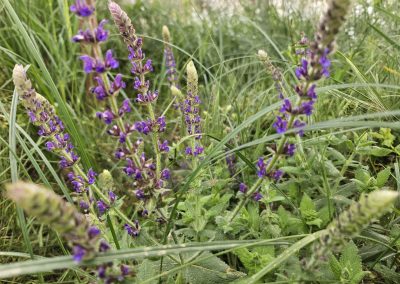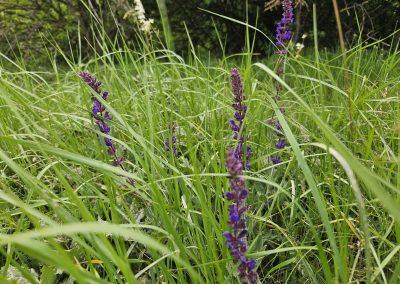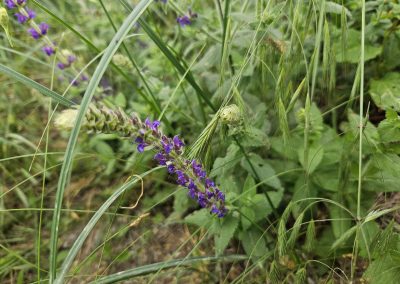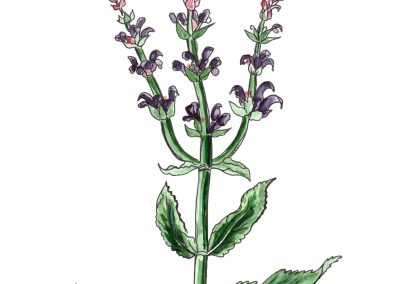Salvia Nemorosa
Scientific description
Salvia nemorosa – Woodland sage / Steppe sage
Phylum: Angiospermatophyta (Magnoliophyta)
Class: Dicotyledonatae (Magnoliatae)
Subclass: Asteridae
Order: Lamiales
Family: Lamiaceae
Origin: Southeastern Europe
Description:
Perennial herbaceous plant with tall stem 20–60 cm, hairy, simple or branched. Lower stem leaves lanceolate or ovate-lanceolate, pointed, crenate margins; middle and upper leaves shortly petiolate to sessile, long pointed tip. Flowers bell-shaped calyx, violet-colored top, violet-blue corolla; upper lip slightly curved, lower lip two elongated lateral lobes. Flowers in vertical inflorescences. Blooms June–September.
Propagation: By seeds or by dividing clumps.
Ecology:
Widely distributed in Central and Southeastern Europe and Southwestern Asia. In Romania: dry meadows, roadsides, uncultivated areas.
Use:
Anti-inflammatory and antimicrobial properties. Ornamental plant: flower gardens, borders, flowerbeds. Attracts bees, butterflies, other pollinators. Ideal with sun-loving perennials such as lavender or echinacea.
Danger:
Threatened by replacement of meadows/shrublands with arable land and overgrazing. Safe, non-invasive, pollinator-friendly, drought-resistant, no major health risks.
Salvia nemorosa – Jaleș de câmp / Salvia nemoroasă
Încrengătura: Angiospermatophyta (Magnoliophyta)
Clasa: Dicotyledonatae (Magnoliatae)
Subclasa: Asteridae
Ordinul: Lamiales
Familia: Lamiaceae
Originea: Sud-estul Europei
Descrierea:
Plantă ierboasă perenă cu tulpina 20–60 cm, păroasă, simplă sau ramificată. Frunzele inferioare lanceolate/ovate-lanceolate, ascuțite, crenate; frunzele mijlocii și superioare scurt pețiolate până la sesile, vârf lung ascuțit. Florile cu caliciu campanulat violet, corolă albastru-violet; labiul superior ușor curbat, inferior cu doi lobi laterali alungiți. Inflorescențe verticale. Înflorește iunie–septembrie.
Înmulțire: Semințe sau divizarea tufei.
Ecologia:
Larg răspândită în Europa centrală și de sud-est, Asia de sud-vest. În România: pajiști uscate, marginea drumurilor, locuri necultivate.
Utilizare:
Proprietăți antiinflamatorii și antimicrobiene. Plantă ornamentală: grădini de flori, borduri, ronduri. Atrage albine, fluturi, alte insecte polenizatoare. Ideală cu plante perene iubitoare de soare (lavandă, echinacea).
Pericol:
Amenințată de înlocuirea pajiștilor și tufărișurilor cu teren arabil și pășunat. Sigură, neinvazivă, prietenoasă cu polenizatorii, rezistentă la secetă, fără riscuri majore pentru sănătate.
Salvia nemorosa – Δασική φασκομηλιά / Φασκομηλιά των στεπών
Γένος: Αγγειόσπερμα (Magnoliophyta)
Κλάση: Δικοτυλήδονα (Magnoliatae)
Υποκλάση: Asteridae
Τάξη: Lamiales
Οικογένεια: Lamiaceae
Προέλευση: Νοτιοανατολική Ευρώπη
Περιγραφή:
Πολυετές ποώδες φυτό, στέλεχος 20–60 εκ., τριχωτό, απλό ή διακλαδισμένο. Κατώτερα φύλλα λογχοειδή ή ωοειδή-λογχοειδή, αιχμηρά, κυματοειδείς άκρες; μεσαία/ανώτερα φύλλα κοντό μίσχο ή άμισχα, μακριά αιχμηρή απόληξη. Άνθη με καμπανοειδή κάλυκα, ιώδη κορυφή, μπλε-ιώδη στεφάνη, άνω χείλος ελαφρώς κυρτό, κάτω δύο λοβοί. Κάθετες ταξιανθίες. Ανθίζει Ιούνιο–Σεπτέμβριο.
Πολλαπλασιασμός: Με σπόρους ή διαίρεση τούφας.
Οικολογία:
Ευρέως διαδεδομένο στην Κεντρική και Νοτιοανατολική Ευρώπη, Νοτιοδυτική Ασία. Στη Ρουμανία: ξηρά λιβάδια, δρόμοι, ακαλλιέργητες περιοχές.
Χρήσεις:
Αντιφλεγμονώδεις και αντιμικροβιακές ιδιότητες. Καλλωπιστικό, ανθόκηποι, μπορντούρες, παρτέρια. Προσελκύει μέλισσες, πεταλούδες, επικονιαστές. Ιδανικό με άλλα πολυετή φυτά που αγαπούν τον ήλιο (λεβάντα, εχινάκεια).
Απειλές:
Απειλείται από μετατροπή λιβαδιών/θάμνων σε γεωργικές εκτάσεις και υπερβόσκηση. Ασφαλές, μη επεμβατικό, φιλικό προς επικονιαστές, ανθεκτικό στη ξηρασία, χωρίς σημαντικούς κινδύνους.
Salvia nemorosa – Sauge des bois / Sauge des steppes
Enchevêtrement: Angiospermatophyta (Magnoliophyta)
Classe: Dicotyledonatae (Magnoliatae)
Sous-classe: Asteridae
Ordre: Lamiales
Famille: Lamiaceae
Origine: Europe du sud-est
Description:
Plante herbacée vivace, tige 20–60 cm, poilue, simple ou ramifiée. Feuilles inférieures lancéolées/ovée-lancéolées, pointues, bords crénelés; feuilles moyennes/supérieures peu pétiolées à sessiles, pointe longue. Fleurs calice campanulé violet, corolle bleu-violet, lèvre supérieure légèrement incurvée, inférieure deux lobes latéraux. Inflorescences verticales. Floraison juin–septembre.
Propagation: Par graines ou division de touffes.
Écologie:
Répandu en Europe centrale et sud-est, Asie du sud-ouest. En Roumanie : prairies sèches, bords de routes, zones non cultivées.
Utilisations:
Propriétés anti-inflammatoires et antimicrobiennes. Plante ornementale : jardins de fleurs, bordures, parterres. Attire abeilles, papillons et pollinisateurs. Idéal avec plantes vivaces soleil (lavande, échinacée).
Menaces:
Menacé par remplacement des prairies/arbustes par terres arables et surpâturage. Sûre, non invasive, pollinisateurs-friendly, résistante à la sécheresse, pas de risques majeurs.
Creative writing inspired by Salvia Nemorosa
Written by
Scafaru Bianca-Mariana
Andreea-Mihaela Tote
The Blessing of the Sage
Long ago, beneath the searing sun and the wide, open skies of ancient lands, a desperate mother fled through the wilderness. Mary, heavy with fear, cradled her precious child, the Holy Infant, against her chest. Behind her, the dust rose — a cloud stirred by the hooves of King Herod’s soldiers, relentless in their cruel hunt.
The desert was merciless, offering few places to hide. Trees stood sparse, their branches too bare to offer cover. Bushes trembled in the hot wind, exposing all who came too near. Mary’s heart pounded as she ran from one dry thicket to another, seeking shelter.
Then she saw it — a bush crowned with small, silvery-green leaves, shimmering under the scorching sun. Unlike the others, this plant seemed alive with a quiet strength. As Mary approached, the sage bush stirred. Its branches, though small, spread wider, weaving together to form a living veil.
Kneeling, Mary pressed herself and the child beneath the fragrant leaves. As the soldiers neared, the air around the bush thickened with the herb’s rich, sweet scent. Confused by the aroma and finding no trace of their prey, the soldiers cursed the barren land and rode away.
Tears of gratitude welled in Mary’s eyes. She looked to the humble plant and whispered a blessing into its trembling leaves: “From this day forth, you shall be beloved among the plants of the earth. I grant you the gift of healing — to save mankind from their sufferings, just as you have saved me and my son.” And so it was. Sage, whose name comes from the Latin salvare, meaning “to save”, became a sacred herb — a protector, a healer, a symbol of salvation.
Throughout the ages, people honored sage not only for its power to preserve food or to flavor the feasts of kings, but also for its sacred touch upon wounds, its strength to clear troubled minds, and its unseen arms that still, even today, offer shelter to the weary soul. And in the old villages of Europe, they called it with reverence: “The Palm of the Mother of God.”






